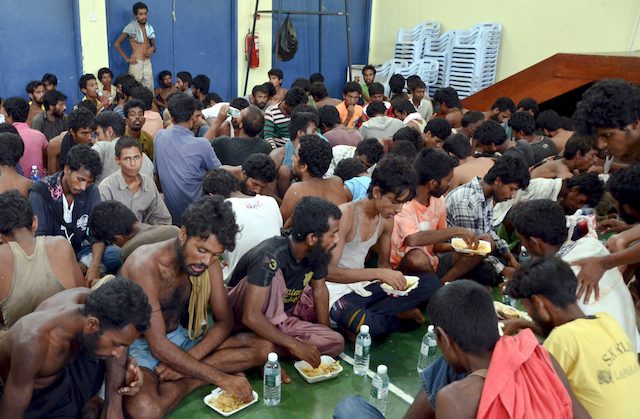SUMMARY
This is AI generated summarization, which may have errors. For context, always refer to the full article.

LANGKAWI, Malaysia (2nd UPDATE) – Thousands of migrants believed to be stranded at sea without food and water could die unless Southeast Asian governments act urgently to rescue them, migrant groups and the UN warned Tuesday, May 12.
The escalating alarm over the region’s refugee crisis came as Indonesia’s navy said it had turned away a boat carrying hundreds of migrants from Myanmar and Bangladesh to an uncertain fate.
Nearly 2,000 boatpeople from Myanmar and Bangladesh have swum ashore, been rescued or intercepted off Malaysia and Indonesia in recent days, many of them thin, weak or in poor health after weeks at sea.
People smugglers are believed to be dumping their human cargoes after being diverted from Thailand – a key stop on human-smuggling routes – where authorities have launched a crackdown on the trade.
The Arakan Project, a group advocating for the rights of Rohingya – a Muslim minority that is unwanted by Myanmar’s government – has said as many as 8,000 people may be adrift.
The International Organization for Migration (IOM) said search and rescue operations were urgently needed.
“It needs a regional effort… we don’t have the capacity to search for them, but governments do. They have boats and satellites,” said Joe Lowry, a Bangkok-based spokesman for the IOM, a 157-member-state intergovernmental organization.
He told Agence France-Presse those still at sea may be in a “very bad condition or even dead” if not found soon.
Thousands of poor Rohingya and Bangladeshis risk the perilous sea and land trafficking route from the Bay of Bengal region through Thailand and into Malaysia each year.
The United Nations High Commissioner for Refugees (UNHCR) has said 25,000 people are believed to have embarked from January to March, double the previous year’s pace, and that an estimated 300 had, died.
Abandoned at sea
“It appears people are holding people captive on the sea because they are afraid to disembark,” said Vivian Tan, spokeswoman for the UNHCR in Bangkok.
She said some vessels, and their passengers, may have been abandoned by smugglers, adding that regional cooperation was needed to address the crisis and that the UNHCR was willing to help.
“There’s definitely a need for countries in the region to come together to see how best to do this,” she said.
Human smuggling has thrived for years in Southeast Asia in the absence of major coordinated efforts by regional authorities to stamp it out or address its root causes.
Indonesia’s navy has turned away a vessel that arrived on the coast of its northwestern Aceh region on Monday carrying an estimated 400 migrants, naval spokesman Manahan Simorangkir told Agence France-Presse Tuesday.
“We gave them fuel and asked them to proceed,” he said of the ship, which has been towed to international waters.
“We are not forcing them to go to Malaysia or Australia. That is not our business. Our business is they don’t enter Indonesia because Indonesia is not the destination.”
On Sunday, May 10, 582 men, women and children had straggled ashore in Aceh from a different boat, with officials saying many were in poor health. They are currently being supplied food and shelter.
Thailand launched its crackdown after discovering dozens of migrant remains in secret jungle camps earlier this month.
It has called for a meeting with Malaysia and Myanmar on trafficking, but the response is not yet known.
‘Needle in a stack of needles’
The IOM’s deputy chief of mission in Indonesia, Steven Hamilton, said any regional effort to find stricken vessels would be daunting.
“It’s like trying to find a needle in a stack of needles, not a needle in a haystack,” he said.
“Those waters are dense with other boats. You’re really not sure what you’re looking for.”
Complicating the picture, he said recent arrivals in Aceh interviewed by IOM staff described an elaborate supply chain at sea with many migrants shifted from one vessel to the next.
Rohingya survivors of the route have previously told Agence France-Presse of harrowing sea passages in which passengers died of hunger or sickness or were beaten to death by smugglers, their bodies tossed overboard.
Ali Hussein, a 31-year-old ethnic Rohingya from Myanmar, is among more than 1,000 people – many of them gaunt and exhausted – who swam ashore in Malaysia from their smuggling ships Sunday and Monday, May 11.
Like thousands of his people, he fled sectarian violence targeting Rohingya in recent years.
“I was running for my life,” he said.
He and about 800 other people endured 43 days on an overcrowded vessel as already-scarce food and water supplies dwindled.
Their Thailand-bound ship diverted to the Malaysian resort island of Langkawi where the hungry passengers leapt into the sea in a desperate swim to safety.
“There was no more food or water so we just jumped out of the boat,” he said.
Buddhist-majority Myanmar views its population of Muslim Rohingya, estimated at more than 1.3 million, as illegal Bangladeshi immigrants.
The UN calls them one of the world’s most persecuted minorities. – M Jegathesan, AFP / Rappler.com
Add a comment
How does this make you feel?
There are no comments yet. Add your comment to start the conversation.